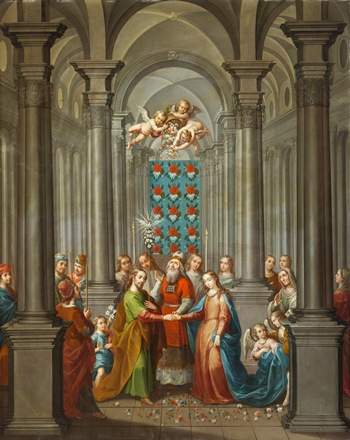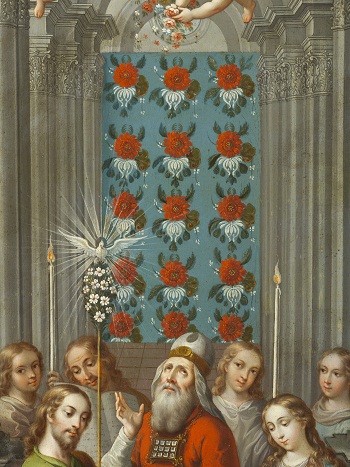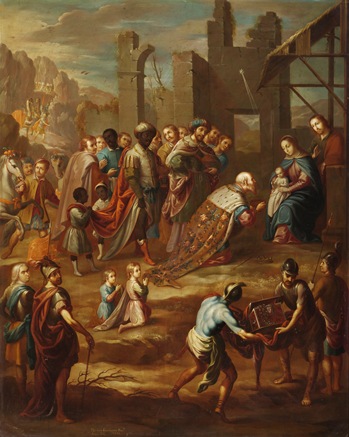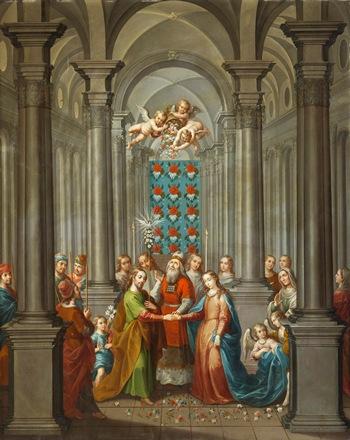These two oil-on-copper paintings are among the finest by Nicolás Enríquez (1704–c. 1790), a distinguished yet understudied eighteenth-century New Spanish (Mexican) painter. They depict scenes from the life of the Virgin: her marriage to Joseph officiated by the Jewish priest and the adoration of the three kings who kneel before the Christ child as they offer him prodigious gifts. These are history paintings in the grand style (gran maniera), designed to tell a story through complex but clear narrative elements and the forceful expressiveness of the figures. Yet, the profusion of ornamentation, such as the delicate floral motifs that pepper the compositions, reflects a typically New Spanish sensibility. Enríquez was a member of the first academy of painters established in Mexico around 1722 by the brothers Juan and Nicolás Rodríguez Juárez (1667–1734; 1675–1728). A primary goal of this group of cultured painters was to gain recognition of the nobility of their art and to set themselves apart from the mechanical arts.

Nicolás Enríquez, The Marriage of the Virgin, 1749, purchased with funds provided by Kelvin Davis, Lynda and Stewart Resnick, Kathy and Frank Baxter, Beth and Josh Friedman, and Jane and Terry Semel through the 2012 Collectors Committee
Enríquez developed a great reputation for his highly finished oil paintings on copper, a support that he used extensively throughout his career. The tradition of copper painting first developed in Italy and Flanders in the sixteenth century, and it was quickly introduced to New Spain, where it became more common than in Europe, especially in the eighteenth century. The smoothness of copper allowed for the almost seamless application of paint, creating dazzling visual effects and granting the paintings a jewel-like quality.

Nicolás Enríquez, The Marriage of the Virgin (detail), 1749, purchased with funds provided by Kelvin Davis, Lynda and Stewart Resnick, Kathy and Frank Baxter, Beth and Josh Friedman, and Jane and Terry Semel through the 2012 Collectors Committee
The rich floral textile in The Marriage of the Virgin, for instance, is a rare pictorial detail despite how prevalent it was to decorate church interiors with imported tapestries and Asian rugs. Equally unusual in New Spanish painting is the detailed architectural rendition of the church. This was a well-established genre in seventeenth-century Dutch and Flemish painting, which Enríquez must have known (either through imported paintings or architectural manuals), allowing him to showcase his skill in rendering a realistic illusion of space.

Nicolás Enríquez, The Adoration of the Kings with Donor, 1741, purchased with funds provided by Kelvin Davis, Lynda and Stewart Resnick, Kathy and Frank Baxter, Beth and Josh Friedman, and Jane and Terry Semel through the 2012 Collectors Committee
In addition, the works are also important art historically. The Adoration of the Kings with Donor is modeled after a painting by the celebrated Mexican painter Juan Rodríguez Juárez in the famous Altar of the Kings of Mexico City’s cathedral, dedicated to the Spanish monarchs in 1737. While in his painting Rodríguez Juárez includes a self-portrait, Enríquez inserts in the lower left the portrait of Mexico City’s Viceroy Pedro de Castro y Figueroa, duke of La Conquista, who arrived in Mexico in 1740 and died tragically of yellow fever a year after taking his post. Standing near a fully decked horse (a quintessential element of the entry ceremonies of incoming viceroys to Mexico), the viceroy is depicted looking out sternly at the viewer. The two kneeling children are in all likelihood portraits of the viceroy’s sons. A remarkable fact is that the viceroy was buried in the Altar of the Kings, which emphasizes his loyalty to the king and makes this posthumous painting particularly poignant. But referencing Juan Rodríguez Juárez’s painting is also an important art-historical gesture: It represents how the tradition of local painting within Mexico itself was as significant as the use of European sources in creating new and vibrant compositions. Enríquez’s paintings are exceptional because of their unusually large scale (most copper paintings are much smaller) and their excellent state of conservation. The two works will feature prominently in an exciting upcoming exhibition of eighteenth-century Mexican painting that I am organizing with a group of colleagues from Mexico and Spain.



